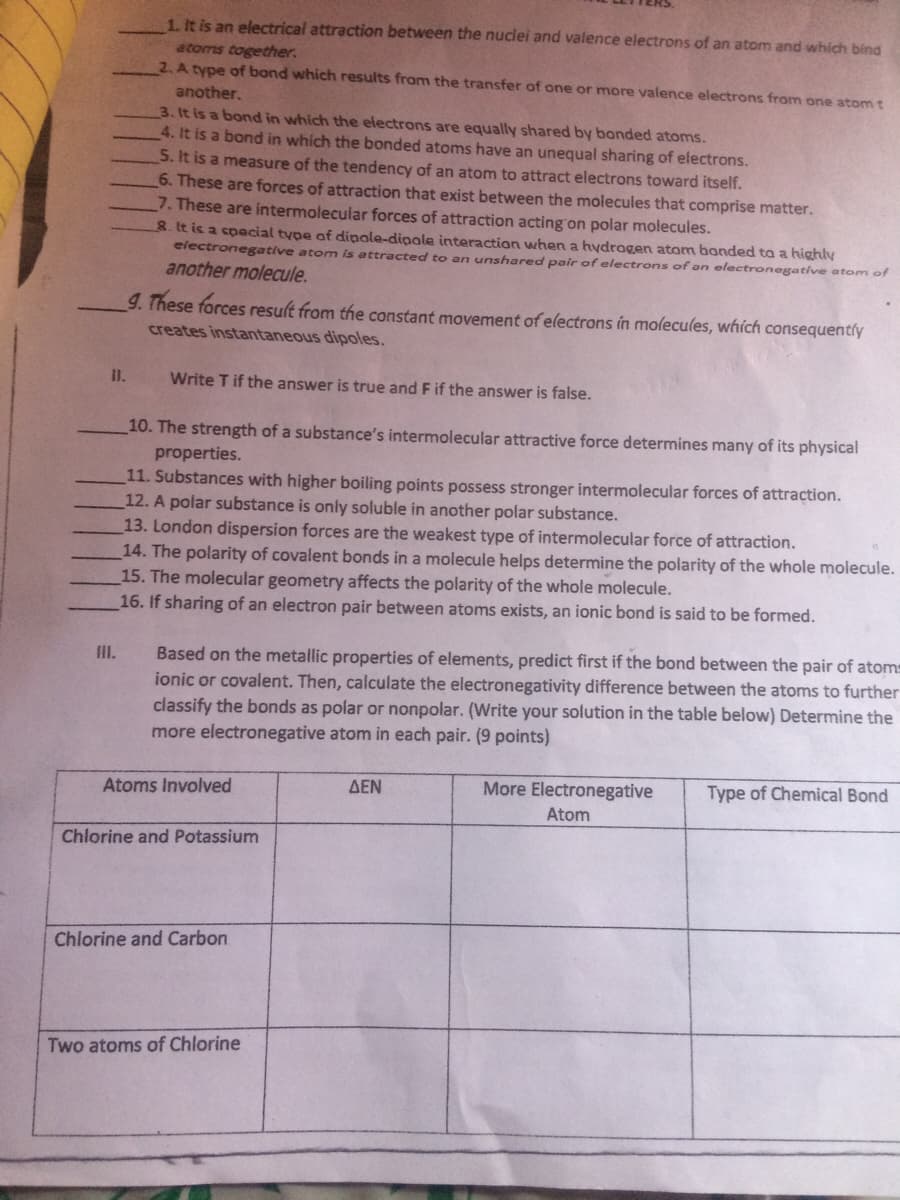1. It is an electrical attraction between the nuclei and valence electrons of an atom and which bind atoms together. 2. A type of bond which results from the transfer of one or more valence electrons from one atomt another. 3. It is a bond in which the electrons are equally shared by bonded atoms. 4. It is a bond in which the bonded atoms have an unequal sharing of electrons. S. It is a measure of the tendency of an atom to attract electrons toward itself. 6. These are forces of attraction that exist between the molecules that comprise matter. 7. These are intermolecular forces of attraction acting on polar molecules. 8 It is a cpecial type of dinole-dipale interaction when a hydrogen atom bonded ta a highly electronegative atom is attracted to an unshared pair of electrons of an electronegative atom of another molecule. 9. These forces result from the constant movement of electrons in molecules, whích consequently creates instantaneous dipoles. I1. Write T if the answer is true and F if the answer is false. 10. The strength of a substance's intermolecular attractive force determines many of its physical properties. 11. Substances with higher boiling points possess stronger intermolecular forces of attraction. 12. A polar substance is only soluble in another polar substance. 13. London dispersion forces are the weakest type of intermolecular force of attraction. 14. The polarity of covalent bonds in a molecule helps determine the polarity of the whole molecule 15. The molecular geometry affects the polarity of the whole molecule. 16. If sharing of an electron pair between atoms exists, an ionic bond is said to be formed. Based on the metallic properties of elements, predict first if the bond between the pair of aton ionic or covalent. Then, calculate the electronegativity difference between the atoms to furthe classify the bonds as polar or nonpolar. (Write your solution in the table below) Determine the more electronegative atom in each pair. (9 points) III. Atoms Involved ΔΕΝ More Electronegative Type of Chemical Bond Atom Chlorine and Potassium Chlorine and Carbon Two atoms of Chlorine
Types of Chemical Bonds
The attractive force which has the ability of holding various constituent elements like atoms, ions, molecules, etc. together in different chemical species is termed as a chemical bond. Chemical compounds are dependent on the strength of chemical bonds between its constituents. Stronger the chemical bond, more will be the stability in the chemical compounds. Hence, it can be said that bonding defines the stability of chemical compounds.
Polarizability In Organic Chemistry
Polarizability refers to the ability of an atom/molecule to distort the electron cloud of neighboring species towards itself and the process of distortion of electron cloud is known as polarization.
Coordinate Covalent Bonds
A coordinate covalent bond is also known as a dative bond, which is a type of covalent bond. It is formed between two atoms, where the two electrons required to form the bond come from the same atom resulting in a semi-polar bond. The study of coordinate covalent bond or dative bond is important to know about the special type of bonding that leads to different properties. Since covalent compounds are non-polar whereas coordinate bonds results always in polar compounds due to charge separation.

Trending now
This is a popular solution!
Step by step
Solved in 2 steps









